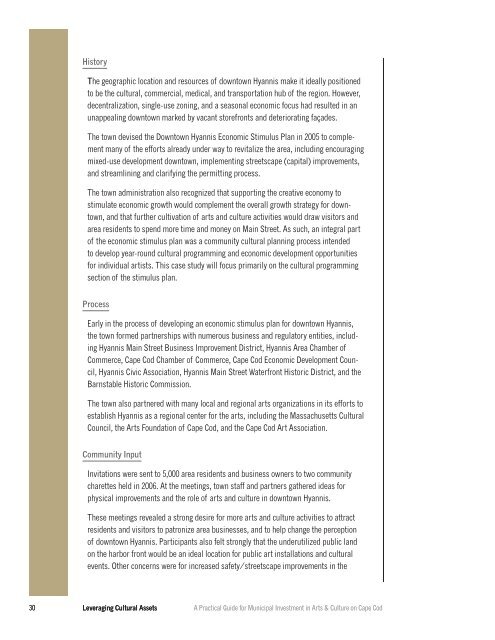Leveraging Cultural Assets for Economic Development - Cape Cod ...
Leveraging Cultural Assets for Economic Development - Cape Cod ...
Leveraging Cultural Assets for Economic Development - Cape Cod ...
- No tags were found...
You also want an ePaper? Increase the reach of your titles
YUMPU automatically turns print PDFs into web optimized ePapers that Google loves.
HistoryThe geographic location and resources of downtown Hyannis make it ideally positionedto be the cultural, commercial, medical, and transportation hub of the region. However,decentralization, single-use zoning, and a seasonal economic focus had resulted in anunappealing downtown marked by vacant storefronts and deteriorating façades.The town devised the Downtown Hyannis <strong>Economic</strong> Stimulus Plan in 2005 to complementmany of the ef<strong>for</strong>ts already under way to revitalize the area, including encouragingmixed-use development downtown, implementing streetscape (capital) improvements,and streamlining and clarifying the permitting process.The town administration also recognized that supporting the creative economy tostimulate economic growth would complement the overall growth strategy <strong>for</strong> downtown,and that further cultivation of arts and culture activities would draw visitors andarea residents to spend more time and money on Main Street. As such, an integral partof the economic stimulus plan was a community cultural planning process intendedto develop year-round cultural programming and economic development opportunities<strong>for</strong> individual artists. This case study will focus primarily on the cultural programmingsection of the stimulus plan.ProcessEarly in the process of developing an economic stimulus plan <strong>for</strong> downtown Hyannis,the town <strong>for</strong>med partnerships with numerous business and regulatory entities, includingHyannis Main Street Business Improvement District, Hyannis Area Chamber ofCommerce, <strong>Cape</strong> <strong>Cod</strong> Chamber of Commerce, <strong>Cape</strong> <strong>Cod</strong> <strong>Economic</strong> <strong>Development</strong> Council,Hyannis Civic Association, Hyannis Main Street Waterfront Historic District, and theBarnstable Historic Commission.The town also partnered with many local and regional arts organizations in its ef<strong>for</strong>ts toestablish Hyannis as a regional center <strong>for</strong> the arts, including the Massachusetts <strong>Cultural</strong>Council, the Arts Foundation of <strong>Cape</strong> <strong>Cod</strong>, and the <strong>Cape</strong> <strong>Cod</strong> Art Association.Community InputInvitations were sent to 5,000 area residents and business owners to two communitycharettes held in 2006. At the meetings, town staff and partners gathered ideas <strong>for</strong>physical improvements and the role of arts and culture in downtown Hyannis.These meetings revealed a strong desire <strong>for</strong> more arts and culture activities to attractresidents and visitors to patronize area businesses, and to help change the perceptionof downtown Hyannis. Participants also felt strongly that the underutilized public landon the harbor front would be an ideal location <strong>for</strong> public art installations and culturalevents. Other concerns were <strong>for</strong> increased safety/streetscape improvements in the30<strong>Leveraging</strong> <strong>Cultural</strong> <strong>Assets</strong> A Practical Guide <strong>for</strong> Municipal Investment in Arts & Culture on <strong>Cape</strong> <strong>Cod</strong>
















